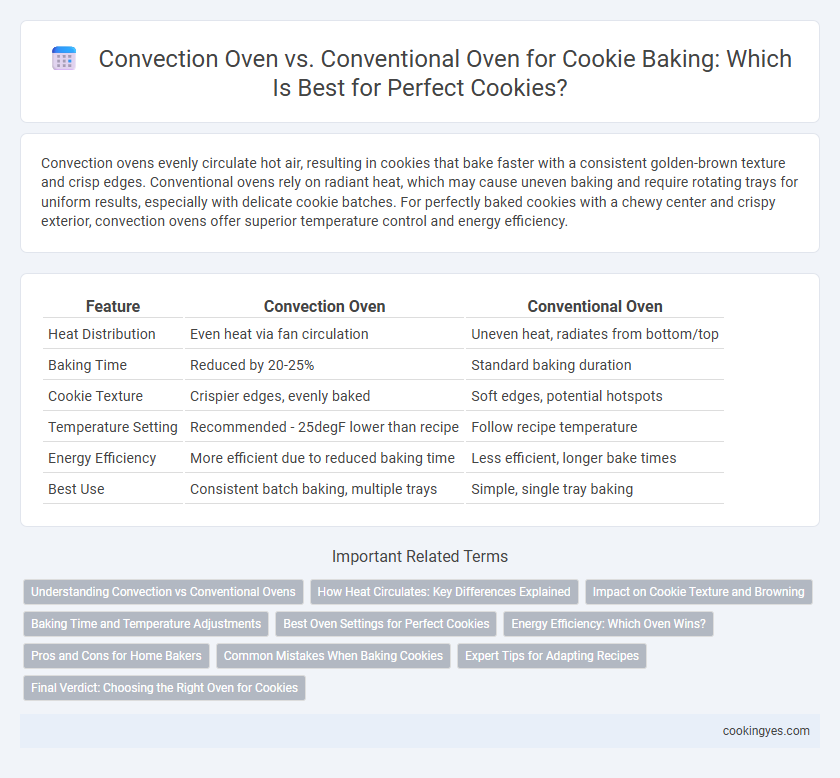Convection ovens evenly circulate hot air, resulting in cookies that bake faster with a consistent golden-brown texture and crisp edges. Conventional ovens rely on radiant heat, which may cause uneven baking and require rotating trays for uniform results, especially with delicate cookie batches. For perfectly baked cookies with a chewy center and crispy exterior, convection ovens offer superior temperature control and energy efficiency.
Table of Comparison
| Feature | Convection Oven | Conventional Oven |
|---|---|---|
| Heat Distribution | Even heat via fan circulation | Uneven heat, radiates from bottom/top |
| Baking Time | Reduced by 20-25% | Standard baking duration |
| Cookie Texture | Crispier edges, evenly baked | Soft edges, potential hotspots |
| Temperature Setting | Recommended - 25degF lower than recipe | Follow recipe temperature |
| Energy Efficiency | More efficient due to reduced baking time | Less efficient, longer bake times |
| Best Use | Consistent batch baking, multiple trays | Simple, single tray baking |
Understanding Convection vs Conventional Ovens
Convection ovens circulate hot air using a fan, promoting even heat distribution that results in faster and more uniform cookie baking, often producing crisper edges and a golden-brown finish. Conventional ovens rely on radiant heat from stationary heating elements, which can create hot spots and uneven baking, potentially causing cookies to bake slower or with inconsistent texture. Understanding these differences helps bakers adjust temperature and timing to optimize cookie quality and achieve desired texture and appearance.
How Heat Circulates: Key Differences Explained
Convection ovens use fans to circulate hot air evenly around cookies, ensuring uniform baking and crisp edges by facilitating consistent heat distribution. Conventional ovens rely on radiant heat from stationary elements, resulting in uneven temperature zones that can cause cookies to bake irregularly. The enhanced airflow in convection ovens reduces baking time and promotes even browning, making them preferable for achieving consistent cookie texture and quality.
Impact on Cookie Texture and Browning
A convection oven uses a fan to circulate hot air, promoting even heat distribution that results in crispier edges and consistent browning on cookies, enhancing texture uniformity. Conventional ovens rely on radiant heat from stationary elements, which can cause uneven cookie baking, often leading to softer centers and less uniform browning. Choosing a convection oven improves cookie texture by reducing baking time and creating a balanced golden crust, ideal for achieving a perfectly baked cookie.
Baking Time and Temperature Adjustments
Convection ovens require reducing baking temperature by 25degF and shortening baking time by 25%, promoting even heat distribution and faster cookie baking. Conventional ovens maintain standard temperature settings, resulting in longer baking times and potential hotspots that can cause unevenly baked cookies. Adjusting temperature and timing optimizes cookie texture and color for each oven type.
Best Oven Settings for Perfect Cookies
Convection ovens offer even heat distribution and consistent temperature control, making them ideal for achieving perfectly baked cookies with uniform texture and color. Setting the convection oven to 325degF and reducing baking time by 25% prevents overbrowning and ensures a tender crumb. Conventional ovens, set at 350degF with a standard baking time, can produce slightly uneven baking, but they maintain moisture well for chewier cookies.
Energy Efficiency: Which Oven Wins?
Convection ovens use a fan to circulate hot air, resulting in faster, more even baking and up to 20% energy savings compared to conventional ovens. Conventional ovens rely on radiant heat, which often causes uneven cookie baking and longer cooking times, increasing energy consumption. For energy-efficient cookie baking, convection ovens offer a significant advantage due to their reduced bake times and consistent temperature distribution.
Pros and Cons for Home Bakers
Convection ovens use a fan to circulate hot air, resulting in more even baking and faster cookie cooking times, which helps achieve consistent browning and crisp edges ideal for home bakers seeking uniform results. Conventional ovens rely on radiant heat without air circulation, often causing uneven heat distribution that may lead to cookies baking unevenly or requiring more careful monitoring. Home bakers benefit from convection ovens when baking multiple trays simultaneously, while conventional ovens provide more familiar temperature control important for delicate cookie recipes prone to drying out under constant airflow.
Common Mistakes When Baking Cookies
Using a convection oven for cookie baking often leads to common mistakes such as overbaking and uneven browning due to the intense air circulation that can dry out the dough quickly. Conventional ovens typically provide more consistent heat, reducing the risk of hot spots and allowing cookies to bake more evenly without the need to lower the temperature drastically. Failing to adjust baking time or temperature when switching between these ovens frequently results in burnt edges or undercooked centers, compromising the perfect cookie texture.
Expert Tips for Adapting Recipes
Using a convection oven for cookie baking requires reducing the oven temperature by 25degF to prevent overbrowning and monitor baking time closely, typically shortening it by 2 to 5 minutes. Conventional ovens offer more consistent heat, making them ideal for delicate recipes but may require rotating the cookie sheets halfway through baking for even results. Experts recommend adjusting ingredient ratios slightly, such as reducing sugar to avoid excessive caramelization in convection baking, ensuring optimal texture and flavor.
Final Verdict: Choosing the Right Oven for Cookies
Convection ovens provide even heat distribution and consistent air circulation, resulting in uniformly baked cookies with a crisp exterior and tender interior, ideal for delicate or intricately shaped batches. Conventional ovens rely on radiant heat from the bottom and top, which may cause uneven baking or hot spots but can be preferable for recipes requiring slower, gentler heating. Selecting the right oven depends on the cookie recipe's texture goals and baking consistency, with convection ovens favored for precision and conventional ovens preferred for traditional baking techniques.
Convection oven vs conventional oven for cookie baking Infographic

 cookingyes.com
cookingyes.com